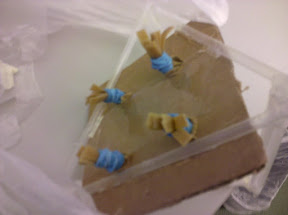The first one looks like this:
 |
| From Egg drop |
Here is a close up of the pyramid section:
 |
| From Egg drop |
You might think that the parachute (aka, plastic grocery bag) would play a big roll in this design, and it did, but not in the way you might think. It did slow the contraption down somewhat, but the egg was still moving pretty fast when it hit the ground. Mostly, the parachute was to make sure that the device stayed upright, and hit the ground with the pyramid pointing down. The most important parts of this design were the straws and the basket made of rubber bands.
It has long been joked that it's not the fall that breaks the egg, it's the sudden stop. And, while often said with a sarcastic tone, that is what an egg drop boils down to. The less suddenly your egg stops, the greater chance it has of surviving.
This design had three ways of lengthening the stopping time of the egg. 1) The parachute slowed down the whole device, so that the egg had a lower speed by the time it came to a stop, 2) the straws bent and cracked so that the whole contraption didn't stop suddenly upon hitting the ground, and 3) the rubber band basket kept the egg from feeling any sudden movements by stretching.
Here are a few more pictures:
 |
| From Egg drop |
 |
| From Egg drop |
 |
| From Egg drop |
My other device was more of a propeller. The idea behind this one was to get it spinning and moving more slowly, and have it float gently to the ground.
 |
| From Egg drop |
It is 90% made out of manila folders, but also includes straws, plastic knives, and liberal amounts of hot glue. If someone is trying to recreate this design, I recommend using wooden skewers instead of knives and straws, but I made this out of materials I could find around the office. I also used some crumpled up pieces of paper shoved in the tube to act as some cushioning, and hold the egg in place.
Here is a video of the propeller performing admirably for a few seconds.
There are two reason for the epic failure of this contraption. What happened in this video is that the device flipped over, and dumped the egg out. I dropped it again later, this time with the egg taped securely inside the tube.
The second problem was one of weight distribution. Most of the weight of this device is centered around the propeller area, and almost none in in the tube. Until there's an egg in there, in which case there is a good percentage of weight at the opposite end of the tube from the propeller. What I should have done is not put so much cushioning in the tube before the egg, so that the egg would have sat closer to where most of the weight of the device was, and it wouldn't have flipped.
No comments:
Post a Comment